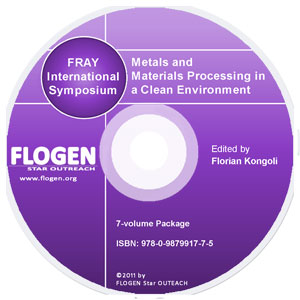
CD shopping page |
2011-Sustainable Industrial Processing Summit
|
| Editors: | Florian K |
| Publisher: | Flogen Star OUTREACH |
| Publication Year: | 2012 |
| Pages: | 708 pages |
| ISBN: | 978-0-9879917-1-3 |
| ISSN: | 2291-1227 (Metals and Materials Processing in a Clean Environment Series) |
Sulfide Capacity Of MnO-containing Slags Measured By Gas-Slag Equilibration Method At 1873 K
Joohyun Park1;1UNIVERSITY OF ULSAN, Ulsan, Korea, South;
Type of Paper: Invite
Id Paper: 216
Topic: 5
Abstract:
The sulfide capacity of the CaO–SiO2–MnO–Al2O3–MgO slags was measured through a wide composition range at 1873 K using a gas–slag equilibration method. The effects of basicity and the activity coefficient of sulfide on the sulfide capacity of molten slag were investigated. Furthermore, the relationship between sulfide capacity and the optical basicity of MnO–containing slags was evaluated in the context of industrial applications. The sulfide capacity of slag increased with increasing content of MnO at a fixed Vee ratio (=CaO/SiO2). The capacity and the modified Vee ratio (=(CaO+MnO+MgO)/(SiO2+Al2O3) showed a good linear relationship. Assuming that the basicity and the stability of the sulfide ions in the slag are proportional to the activity of MnO (aMnO) and the activity coefficient of MnS (rMnS), the composition dependency of sulfide capacity is well described by changes in the aMnO to rMnS ratio. We also constructed the iso–sulfide capacity of the CaO–SiO2–MnO and the CaO–SiO2–MnO–20wt%Al2O3–5wt%MgO slags at 1873 K, respectively. The capacity contours seemed to rotate clock–wisely from the CaO–SiO2 binary side to the MnO–corner in ternary system, whereas the capacity contours seemed to be parallel to the monoxide (Mn,Ca)O saturating line in 5 component system. The sulfide capacity dominantly decreased with increasing silica content in the latter system. The sulfide capacity generally increased with increasing MnO content regardless of changes in the contents of other constituents in multicomponent MnO–containing slags.